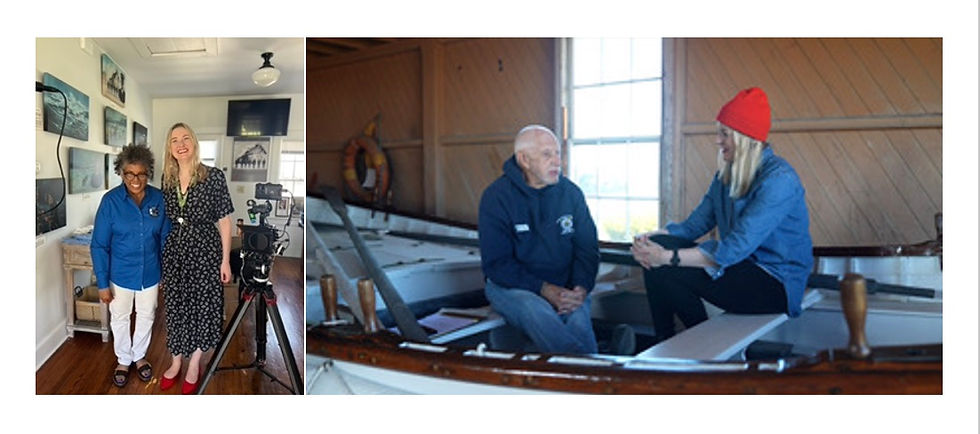PBS show North Carolina Weekend features Outer Banks life-saving stations
- Corinne Saunders

- Nov 14, 2024
- 4 min read

Joan Collins of the Pea Island Preservation Society, Inc., (far left) stands with PBS Director/Producer Rebecca Ward at the Pea Island Cookhouse Museum in Manteo. (Photo courtesy Pea Island Preservation Society, Inc.) Pictured on the right, Ward interviews John Griffin (blue sweatshirt), executive director of the Chicamacomico Historic Site, in Rodanthe. They are seated in Surfboat No. 1046, which was used in the Mirlo rescue of 1918. (Photo courtesy PBS)
By Corinne Saunders
MANTEO — Before the United States Coast Guard existed, surfmen with the U.S. Life-Saving Service rescued people in the treacherous seas off the coast of North Carolina’s Outer Banks.
Daring rescues were performed “with little more than wooden boats, ropes and line-throwing guns,” according to a new PBS North Carolina Weekend episode, “Salt and Seas.” The episode features two sites that preserve history from what once were seven U.S. Life-Saving Service stations along the Outer Banks, according to its online preview.
The episode airs on TV starting the evening of Thursday, Nov. 14, and features interviews with Joan Collins, director of outreach and education for the Pea Island Preservation Society, Inc., and with John Griffin, executive director of the Chicamacomico Historic Site.
Collins in her NC Weekend interview cited the historical importance of the life-saving stations.
“This is not local history; this is national history,” Collins said in the episode preview. “We always tell people, it’s not just the history of the United States Life-Saving Service and what surfmen did…all the dots connect from the Civil War, the fight for freedom, black watermen.”
Her interview was filmed in the Pea Island Cookhouse Museum in Manteo.
The small building where Pea Island Life-Saving Station surfmen once cooked and ate their meals was moved to Manteo, renovated and opened as a museum in 2008, according to a Nov. 5 press release that Collins wrote and sent to area news outlets. The museum is currently only open for special events, as future facility improvements are being planned.
Griffin was filmed at the Chicamacomico Historic Site in Rodanthe, and he sat in a wooden boat for part of the interview.
He said in the online episode preview that it was the same surfboat used in the 1918 Mirlo rescue during World War I. The British oil tanker was “hemorrhaging aviation fuel,” and surfmen made several trips out to the ship and back to ultimately save 42 of the 51 British seamen onboard, he said.
A German submarine torpedoed that fully loaded tanker, and Keeper John Allen Midgett Jr. and the surfmen under his command performed that well-known rescue, Collins wrote in her release.
“This site [Chicamacomico] was the first of the seven stations [in North Carolina] to be fully operational and serves as a full-time public museum and attraction,” Collins wrote in her press release, noting that the station recently celebrated its 150th anniversary.
The USLSS station at Pea Island, meanwhile, is likely best remembered for the October 11, 1896, rescue of nine people from the shipwrecked schooner named the E.S. Newman by “Keeper Richard Etheridge and his crew during a hurricane,” Collins said in her interview.
Etheridge grew up enslaved on Roanoke Island. He fought during the Civil War and then became the first Black keeper, or commander, of any USLSS station in the country, Collins noted in the press release. “The Pea Island station is also the only in USLSS history with an all-Black crew.”
Collins has a personal connection to the Pea Island station. Her father, Herbert M. Collins, served there during World War II, and her grandfather, his uncle and his great-uncle also served there, she said in her interview.
The Pea Island and Chicamacomico stations operated as “sister” stations, as they were in close proximity and were often called to perform joint rescues, Collins wrote in her press release.
“Rescues at sea during the USLSS and early U.S. Coast Guard era, and when no modern technology existed, were extremely dangerous and difficult, often calling for stations to join forces in an attempt to save lives,” she wrote.
Both sites serve as reminders of the time when surfmen, both Black and white, “patrolled the North Carolina coast and saved the lives of thousands of shipwrecked victims,” Collins wrote.
She told Outer Banks Insider on Thursday that Pea Island Preservation Society, Inc., is enthusiastic about the forthcoming episode.
“Having a public television station like PBS to feature us is exciting news for our organization,” Collins said.
“We have seen the interest shown when people visit the Cookhouse and learn about the only
all-Black USLSS station in the nation's history, and of the obstacles they overcame,” she continued. “This will allow thousands across the country and beyond to learn a facet of American history that unfortunately most do not know.”
Griffin could not be immediately reached for comment on Thursday.
To watch the full episode online, visit the PBS North Carolina website at https://video.pbsnc.org/video/salt-and-seas-srzetn/ or the PBS North Carolina Weekend YouTube channel at https://www.youtube.com/@ncweekend.
The episode will air on TV on the NC Weekend program on Thursday, Nov. 14, at 9 p.m., Friday, Nov. 15, at 5 p.m. and Tuesday, Nov. 19, at 7:30 p.m., according to the release. For the full TV viewing schedule, visit https://www.pbsnc.org/schedule/.
For more information about the Pea Island Preservation Society, Inc., or about the
Chicamacomico Historical Site, visit www.peaislandpreservationsociety.com or
chicamacomico.org, respectively.
Editor’s Note: Want access to all of Outer Banks Insider’s ad-free, quality local reporting? Subscribe today.




Comments